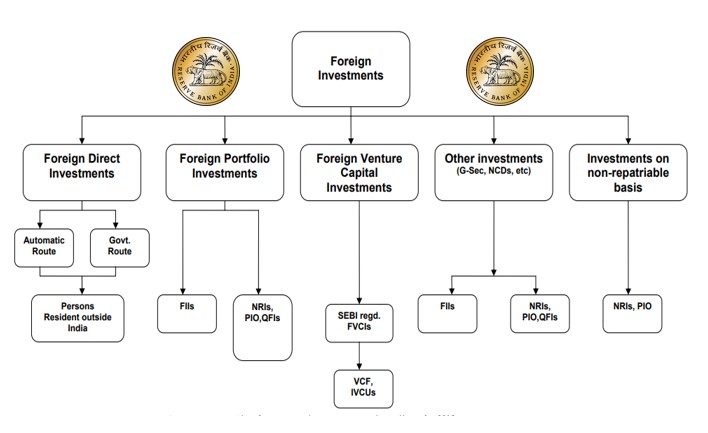Decoding Foreign Investment in India: FDI, FPI, and the Evolving Rules | (Sat 11 May 2024 05:26)

The Reserve Bank of India (RBI) introduced a streamlined operational framework to allow foreign portfolio investors (FPIs) to convert their investments to foreign direct investment (FDI). Foreign investment in India is governed by the Foreign Exchange Management Act (FEMA) of 1999, particularly sub-section (3) of Section 6. The two primary forms of foreign investment in India are Foreign Direct Investment (FDI) and Foreign Portfolio Investment (FPI). Both types play crucial roles in India's economic development but differ significantly in terms of structure, involvement, and regulation.
What are FDI and FPI?
Foreign Direct Investment (FDI)
Definition:
FDI refers to investment by a foreign entity in a company or enterprise located in another country, typically to gain a substantial ownership stake and influence the management or operations of the business.
Nodal Ministry:
The Department for Promotion of Industry and Internal Trade (DPIIT), Ministry of Commerce and Industry, is responsible for FDI policies.
Type of Investment:
Direct investment in the business operations, such as mergers, acquisitions, or partnerships.
Market:
FDI typically involves inflows in the primary market (i.e., direct investment into the company).
Investor Role:
Active involvement in the company, including potential decision-making and strategic influence.
Degree of Control:
FDI investors generally have direct control over the management and operations of the company they invest in.
Term:
FDI is usually a long-term investment.
Investment Instruments:
Direct capital investments, including mergers, acquisitions, joint ventures, and partnerships.
Entry and Exit:
Entry into an FDI market is difficult, and exiting can also be complex due to regulations and the need for long-term commitment.
Risk Profile:
FDI is considered a stable investment but can be affected by political, regulatory, and operational risks.
Foreign Portfolio Investment (FPI)
Definition:
FPI involves foreign investment in financial assets such as stocks, bonds, or other securities traded on the secondary market. Unlike FDI, FPI does not involve significant influence over the company's management.
Nodal Ministry:
The Ministry of Finance oversees FPI regulation.
Type of Investment:
Indirect investment through marketable securities like stocks, bonds, and mutual funds.
Market:
FPIs typically invest in the secondary market (i.e., buying and selling of shares, bonds, etc.).
Investor Role:
Passive investors, with no direct influence on the day-to-day operations or management of the companies they invest in.
Degree of Control:
FPIs have no direct control over company management but can influence decisions through voting at shareholder meetings.
Term:
FPI investments are generally short-term, seeking quicker returns.
Investment Instruments:
Stocks, bonds, ADRs, GDRs, mutual funds, and exchange-traded funds (ETFs).
Entry and Exit:
FPI entry and exit are relatively easy compared to FDI, offering flexibility.
Risk Profile:
FPI investments are more volatile due to market fluctuations, including currency risk and political risk.
Pros and Cons of Foreign Portfolio Investment (FPI)
The introduction of the "Single FPI Regime" on June 1, 2014, consolidated Foreign Institutional Investors (FIIs), their sub-accounts, and Qualified Foreign Investors (QFIs) into a unified system.
Pros of FPI:
-
Increased Capital Availability: FPI inflows can enhance the capital available for businesses, promoting growth.
-
Liquidity Boost: Foreign investment can increase liquidity in domestic financial markets.
-
Quick Returns: FPIs typically look for short-term gains and can offer quick returns on investments.
-
Encourages Growth Investment: FPI channels capital into sectors with growth potential.
-
Brings Foreign Exchange: FPI brings foreign currency into India, strengthening the economy.
Cons of FPI:
-
Market Volatility: Large-scale outflows during market downturns can create instability.
-
No Management Control: FPIs do not influence company management, limiting involvement in decision-making.
-
Political Risk Exposure: FPIs are vulnerable to political changes and regulatory risks.
New Regulatory Framework for FPI
In 2019, the Foreign Exchange Management (Non-debt Instruments) Rules introduced a new regulatory framework for FPI investments.
Key Features:
-
FPI Threshold:
Investments by FPIs should be less than 10% of the total paid-up equity capital of a company. -
Exceeding the Threshold:
If FPIs exceed the 10% limit, they must divest their holdings or reclassify them within 5 trading days. -
Approvals:
Investment by FPIs requires approval from both the Indian government and the invested company. -
Disclosure Requirements:
FPIs must disclose their ownership structure and the ultimate beneficial owners to ensure compliance with the regulations. -
Reclassification Process:
If an FPI exceeds the threshold and chooses reclassification, it must notify its custodian. The custodian will facilitate the transfer of securities to the designated FDI account. -
Prohibited Sectors:
Reclassification is not allowed in sectors prohibited for FDI, such as defense and telecommunications, to safeguard national security.
Implications of the Regulatory Framework
-
Streamlined Foreign Investments:
The framework offers a structured pathway for FPIs that exceed the threshold to retain their investments while complying with regulations. -
Market Stability:
The new rules aim to reduce market volatility by encouraging FPIs to convert into FDI, which is typically a more stable form of investment. -
Enhanced Governance and Transparency:
Increased disclosure requirements ensure better transparency regarding the ownership and beneficiaries of foreign investments, which can improve governance standards. -
Increased Compliance Costs:
The stringent compliance requirements may increase costs for FPIs, particularly those related to beneficial ownership disclosures. -
Promotion of Long-Term Investments:
The regulatory changes encourage FPIs to move towards long-term investments, fostering a more stable and resilient investment environment in India. -
Impact on Investment Patterns:
With caps on ownership in sensitive sectors, FPIs may shift their focus to non-sensitive industries, potentially reducing foreign investment in certain sectors such as defense and telecom. -
Prevention of Tax Evasion:
The regulations aim to prevent tax evasion and money laundering by ensuring proper reporting of ownership structures and investments.
What Lies Ahead?
Moving forward, India will need to maintain a focus on transparency while ensuring that it remains competitive in attracting foreign capital. The government’s aim is to reduce market volatility and build a resilient economic foundation that is less susceptible to short-term market shocks. By promoting long-term investment strategies and enhancing governance structures, India hopes to create a more stable and attractive environment for foreign investors.

Physics, Chemistry, Biology and Geography.

Computer Programming, languages & their frameworks.

Economics, Accounts and Management.

Reviewing old and new books.

Ancient, Medieval, Modern, World History.

Indian Constitution, Politics, Policies, etc.

Everything related to International Affairs.

For all humanities topics, except History & Polity.

Anything related to entertainment industry.

Mainly Cricket but other sports too.

CS, IT, Services & Corporate Sector.
Comments
No comments yet. Be the first to comment!
Leave a Comment